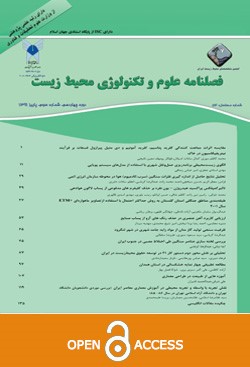تاثیر تعداد جدارههای لایه درونی و بیرونی نماهای دوپوسته بر میزان مصرف انرژی ساختمانهای اداری و آموزشی (مطالعه ساختمان دانشکده علوم پایه دانشگاه علم و صنعت ایران)
محورهای موضوعی : مدیریت محیط زیست
فاطمه مهدیزاده سراج
1
,
محمد مهدی دانش
2
*
,
هانیه صنایعیان
3
![]()
1 - دانشیار دانشکده معماری و شهرسازی دانشگاه علم و صنعت ایران
2 - دانشجوی کارشناسی ارشد معماری دانشکده معماری و شهرسازی دانشگاه علم و صنعت ایران *(مسئول مکاتبات)
3 - دانشجوی دکتری معماری دانشکده معماری و شهرسازی دانشگاه علم و صنعت ایران
کلید واژه: نمای دوپوسته, مصرفانرژی, ساختمان اداری و آموزشی,
چکیده مقاله :
زمینه و هدف: ظهور کامپیوترها و دیگر ابزارهای الکتریکی در ساختمان های اداری و آموزشی باعث شده دمای داخلی این ساختمان ها بالا رود و با وجود نماهای شیشه ای گسترده، افزایش دمای داخلی دوچندان می شود. مسئله این است که چگونه می توان دمای آسایش داخل را، در حالی که از نمای شیشه ای گسترده برای ارتباط بصری با بیرون برخوردار هستیم، بدون افزایش مصرف انرژی جهت سرمایش و گرمایش حفظ کرد؟ هدف از این مطالعه تعیین تاثیر تعداد جداره های لایه درونی و بیرونی نماهای دوپوسته برافزایش قابلیت نمای دوپوسته در صرفه جویی در مصرف انرژی می باشد. روش بررسی: روش پژوهش در این مقاله بر مبنای پژوهش علی و شبیه سازی است. ابزار مورد استفاده در این پژوهش نرم افزار شبیه ساز حرارتی Design Builder می باشد. حالات گوناگون جداره ها در هر لایه در نماهای دو پوسته با بهره گیری از این نرم افزار مورد تحلیل قرار گرفت تا بتوان به حداکثر کاهش مصرف انرژی در ساختمان دست یافت. یافته ها: نتیجه حاصل نشان می دهد که در نمای دوپوسته تغییر در تعداد جداره لایه درونی در کاهش مصرف انرژی موثر تر می باشد و تغییر در تعداد جداره لایه بیرونی در جهت کاهش مصرف انرژی نقشی ایفا نمی کند. حضور بیشتر تابش آفتاب در جبهه جنـوبی باعث می شود که استفاده از نمای دو پوسته در این جبهه موثرتر باشد. نتایج: با توجه به درجه روز گرمایش و سرمایش شهر تهران که به ترتیب برابر است با 1610 و 1435 درجه سانتی گراد، در فصول گرم قابلیت سکنی پذیری و سطح آسایش ساکنان بیشتر خواه بود. بنابراین در تابستان نیز تغییر در تعداد جداره های لایه درونی موثر تر از لایه بیرونی می باشد.
Introduction: The presence of computers and working equipments in official and educational buildings caused the increasing of internal temperature and using glass façade vastly has caused more negative effects of this problem. The question is how to reach to the comfort degree of internal temperature without using excessive energy at the same time of benefitting the visual beauty of the glass façade. The aim of this study is to evaluate the effects of the quantity of layers of the internal and external of double skin façade on energy consumption. Methods of study: The method of this research is based on causal modeling and simulation. The used equipment was the software of thermostatic simulator called “Design Builder”. In order to reach to the lowest level of energy consumption, different modes of the layers in the double skin façade were analyzed by using the design builder software. Findings: The results revealed that in double skin facades, changes in the number of inner layer are efficient in reducing energy consumption, while the outer layer of glazing does not play any role. Using the double skin facade in southern side is more effective because of the sun radiation on this side. Results: Due to the heating and cooling degree days in Tehran which is equal to 1610 and 1435°C respectively, in the summer, habitability and comfort level of residents were demanded mostly. So in the summer, change in the number of inner layers is more effective than the outer layer.

